Educational Strategy for Inclusion of Aboriginal Students
VerifiedAdded on 2023/04/21
|10
|2274
|419
AI Summary
This document discusses the educational strategy for the inclusion of Aboriginal and Torres Strait Islander students in the Australian education system. It explores policies, strategies, and lesson plans to create a culturally competent environment and improve educational outcomes for these students.
Contribute Materials
Your contribution can guide someone’s learning journey. Share your
documents today.
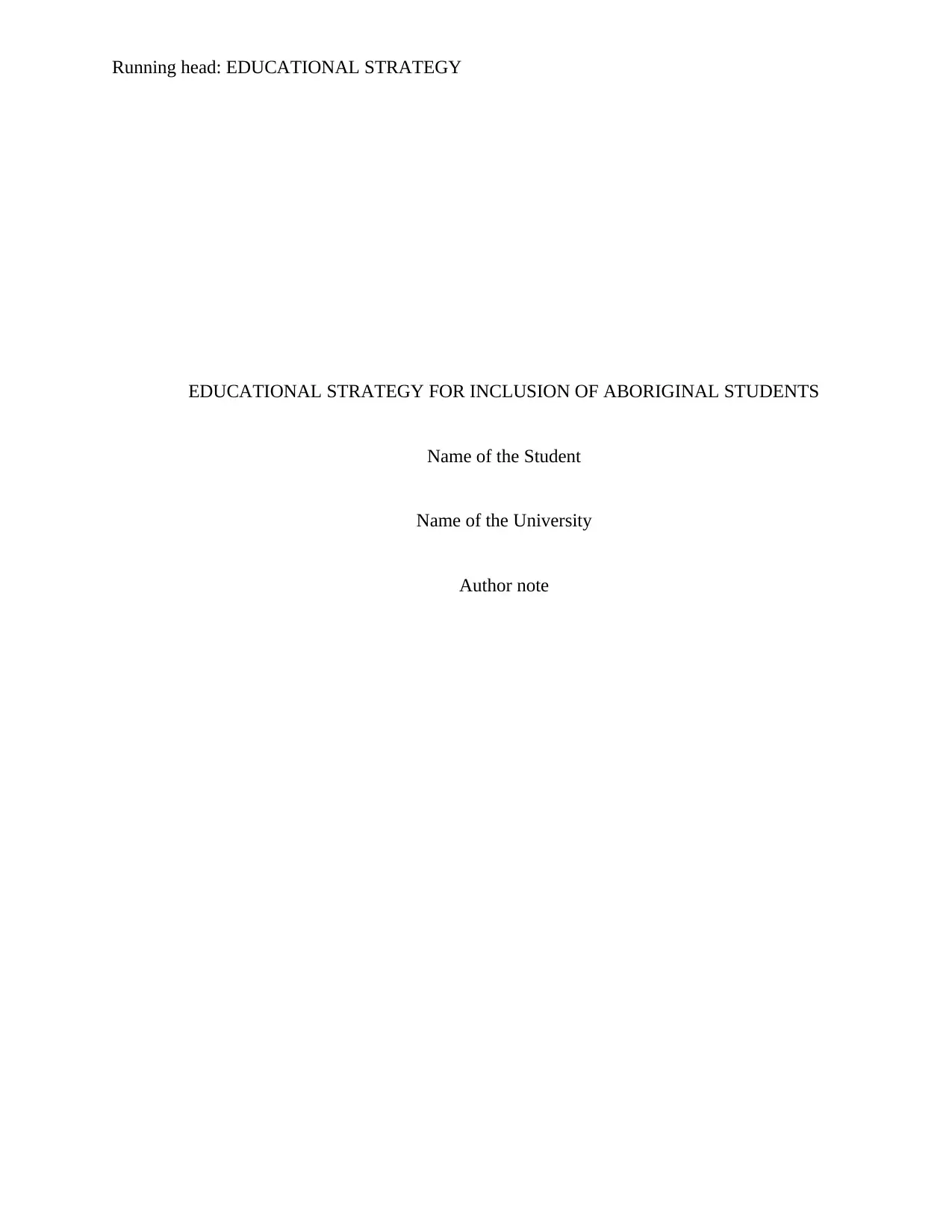
Running head: EDUCATIONAL STRATEGY
EDUCATIONAL STRATEGY FOR INCLUSION OF ABORIGINAL STUDENTS
Name of the Student
Name of the University
Author note
EDUCATIONAL STRATEGY FOR INCLUSION OF ABORIGINAL STUDENTS
Name of the Student
Name of the University
Author note
Secure Best Marks with AI Grader
Need help grading? Try our AI Grader for instant feedback on your assignments.
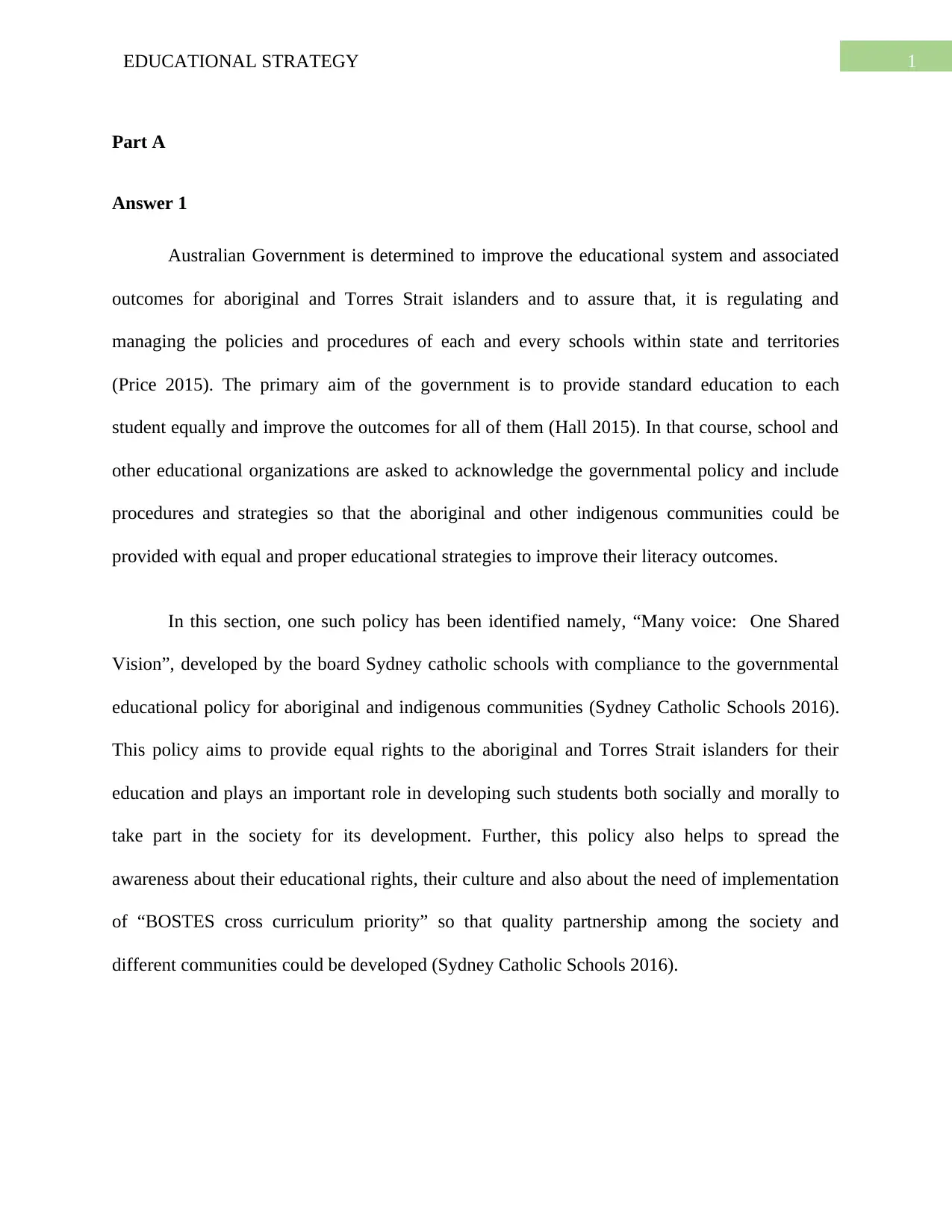
1EDUCATIONAL STRATEGY
Part A
Answer 1
Australian Government is determined to improve the educational system and associated
outcomes for aboriginal and Torres Strait islanders and to assure that, it is regulating and
managing the policies and procedures of each and every schools within state and territories
(Price 2015). The primary aim of the government is to provide standard education to each
student equally and improve the outcomes for all of them (Hall 2015). In that course, school and
other educational organizations are asked to acknowledge the governmental policy and include
procedures and strategies so that the aboriginal and other indigenous communities could be
provided with equal and proper educational strategies to improve their literacy outcomes.
In this section, one such policy has been identified namely, “Many voice: One Shared
Vision”, developed by the board Sydney catholic schools with compliance to the governmental
educational policy for aboriginal and indigenous communities (Sydney Catholic Schools 2016).
This policy aims to provide equal rights to the aboriginal and Torres Strait islanders for their
education and plays an important role in developing such students both socially and morally to
take part in the society for its development. Further, this policy also helps to spread the
awareness about their educational rights, their culture and also about the need of implementation
of “BOSTES cross curriculum priority” so that quality partnership among the society and
different communities could be developed (Sydney Catholic Schools 2016).
Part A
Answer 1
Australian Government is determined to improve the educational system and associated
outcomes for aboriginal and Torres Strait islanders and to assure that, it is regulating and
managing the policies and procedures of each and every schools within state and territories
(Price 2015). The primary aim of the government is to provide standard education to each
student equally and improve the outcomes for all of them (Hall 2015). In that course, school and
other educational organizations are asked to acknowledge the governmental policy and include
procedures and strategies so that the aboriginal and other indigenous communities could be
provided with equal and proper educational strategies to improve their literacy outcomes.
In this section, one such policy has been identified namely, “Many voice: One Shared
Vision”, developed by the board Sydney catholic schools with compliance to the governmental
educational policy for aboriginal and indigenous communities (Sydney Catholic Schools 2016).
This policy aims to provide equal rights to the aboriginal and Torres Strait islanders for their
education and plays an important role in developing such students both socially and morally to
take part in the society for its development. Further, this policy also helps to spread the
awareness about their educational rights, their culture and also about the need of implementation
of “BOSTES cross curriculum priority” so that quality partnership among the society and
different communities could be developed (Sydney Catholic Schools 2016).
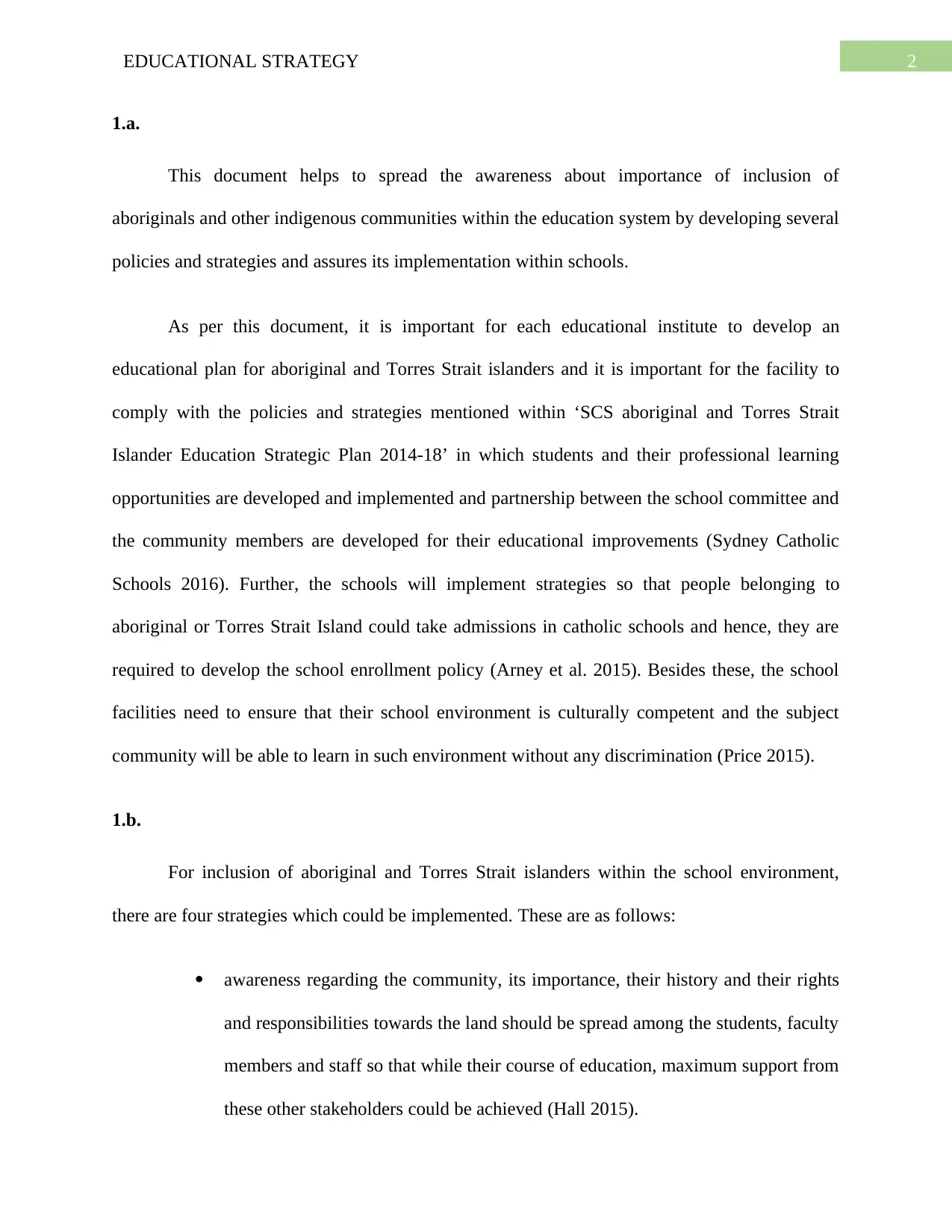
2EDUCATIONAL STRATEGY
1.a.
This document helps to spread the awareness about importance of inclusion of
aboriginals and other indigenous communities within the education system by developing several
policies and strategies and assures its implementation within schools.
As per this document, it is important for each educational institute to develop an
educational plan for aboriginal and Torres Strait islanders and it is important for the facility to
comply with the policies and strategies mentioned within ‘SCS aboriginal and Torres Strait
Islander Education Strategic Plan 2014-18’ in which students and their professional learning
opportunities are developed and implemented and partnership between the school committee and
the community members are developed for their educational improvements (Sydney Catholic
Schools 2016). Further, the schools will implement strategies so that people belonging to
aboriginal or Torres Strait Island could take admissions in catholic schools and hence, they are
required to develop the school enrollment policy (Arney et al. 2015). Besides these, the school
facilities need to ensure that their school environment is culturally competent and the subject
community will be able to learn in such environment without any discrimination (Price 2015).
1.b.
For inclusion of aboriginal and Torres Strait islanders within the school environment,
there are four strategies which could be implemented. These are as follows:
awareness regarding the community, its importance, their history and their rights
and responsibilities towards the land should be spread among the students, faculty
members and staff so that while their course of education, maximum support from
these other stakeholders could be achieved (Hall 2015).
1.a.
This document helps to spread the awareness about importance of inclusion of
aboriginals and other indigenous communities within the education system by developing several
policies and strategies and assures its implementation within schools.
As per this document, it is important for each educational institute to develop an
educational plan for aboriginal and Torres Strait islanders and it is important for the facility to
comply with the policies and strategies mentioned within ‘SCS aboriginal and Torres Strait
Islander Education Strategic Plan 2014-18’ in which students and their professional learning
opportunities are developed and implemented and partnership between the school committee and
the community members are developed for their educational improvements (Sydney Catholic
Schools 2016). Further, the schools will implement strategies so that people belonging to
aboriginal or Torres Strait Island could take admissions in catholic schools and hence, they are
required to develop the school enrollment policy (Arney et al. 2015). Besides these, the school
facilities need to ensure that their school environment is culturally competent and the subject
community will be able to learn in such environment without any discrimination (Price 2015).
1.b.
For inclusion of aboriginal and Torres Strait islanders within the school environment,
there are four strategies which could be implemented. These are as follows:
awareness regarding the community, its importance, their history and their rights
and responsibilities towards the land should be spread among the students, faculty
members and staff so that while their course of education, maximum support from
these other stakeholders could be achieved (Hall 2015).
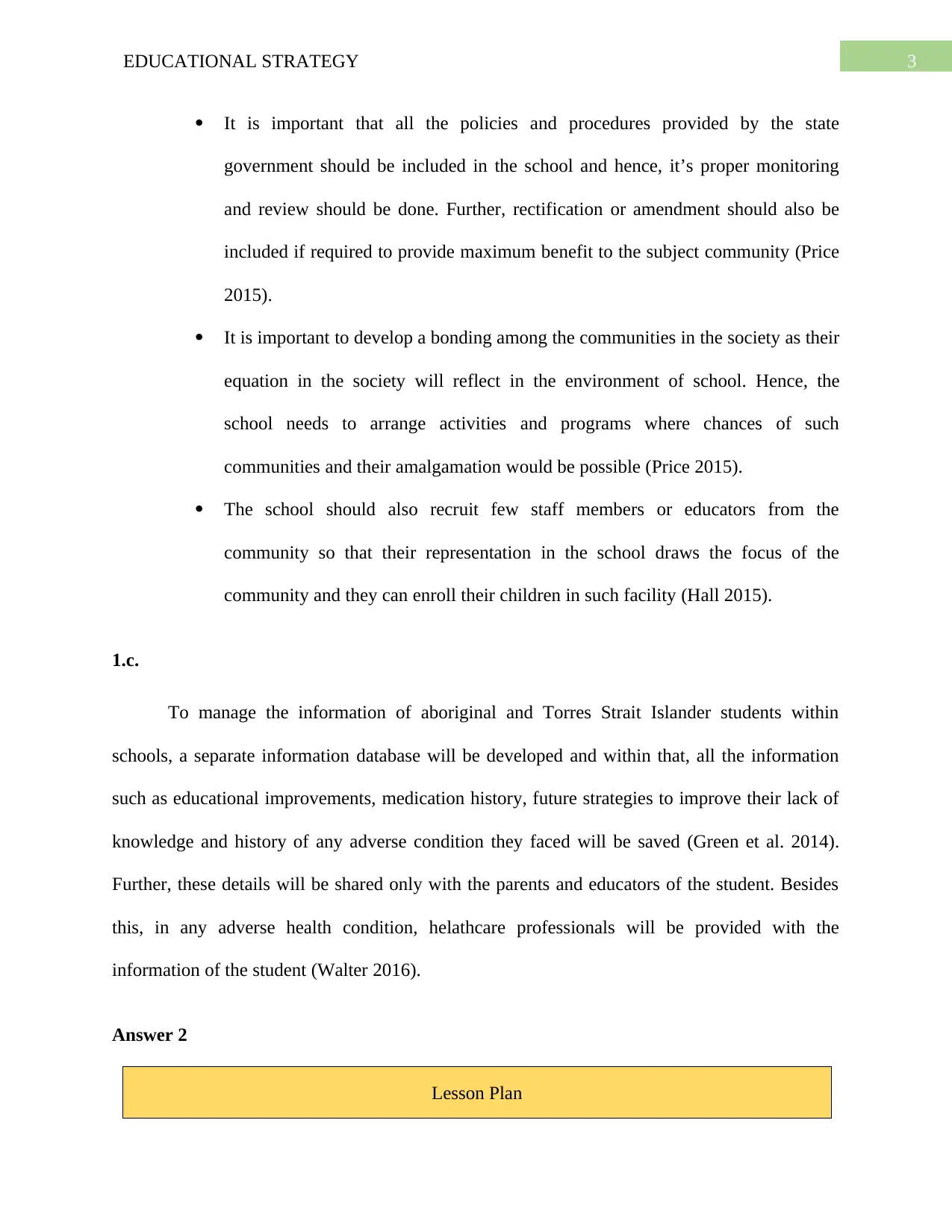
3EDUCATIONAL STRATEGY
It is important that all the policies and procedures provided by the state
government should be included in the school and hence, it’s proper monitoring
and review should be done. Further, rectification or amendment should also be
included if required to provide maximum benefit to the subject community (Price
2015).
It is important to develop a bonding among the communities in the society as their
equation in the society will reflect in the environment of school. Hence, the
school needs to arrange activities and programs where chances of such
communities and their amalgamation would be possible (Price 2015).
The school should also recruit few staff members or educators from the
community so that their representation in the school draws the focus of the
community and they can enroll their children in such facility (Hall 2015).
1.c.
To manage the information of aboriginal and Torres Strait Islander students within
schools, a separate information database will be developed and within that, all the information
such as educational improvements, medication history, future strategies to improve their lack of
knowledge and history of any adverse condition they faced will be saved (Green et al. 2014).
Further, these details will be shared only with the parents and educators of the student. Besides
this, in any adverse health condition, helathcare professionals will be provided with the
information of the student (Walter 2016).
Answer 2
Lesson Plan
It is important that all the policies and procedures provided by the state
government should be included in the school and hence, it’s proper monitoring
and review should be done. Further, rectification or amendment should also be
included if required to provide maximum benefit to the subject community (Price
2015).
It is important to develop a bonding among the communities in the society as their
equation in the society will reflect in the environment of school. Hence, the
school needs to arrange activities and programs where chances of such
communities and their amalgamation would be possible (Price 2015).
The school should also recruit few staff members or educators from the
community so that their representation in the school draws the focus of the
community and they can enroll their children in such facility (Hall 2015).
1.c.
To manage the information of aboriginal and Torres Strait Islander students within
schools, a separate information database will be developed and within that, all the information
such as educational improvements, medication history, future strategies to improve their lack of
knowledge and history of any adverse condition they faced will be saved (Green et al. 2014).
Further, these details will be shared only with the parents and educators of the student. Besides
this, in any adverse health condition, helathcare professionals will be provided with the
information of the student (Walter 2016).
Answer 2
Lesson Plan
Secure Best Marks with AI Grader
Need help grading? Try our AI Grader for instant feedback on your assignments.
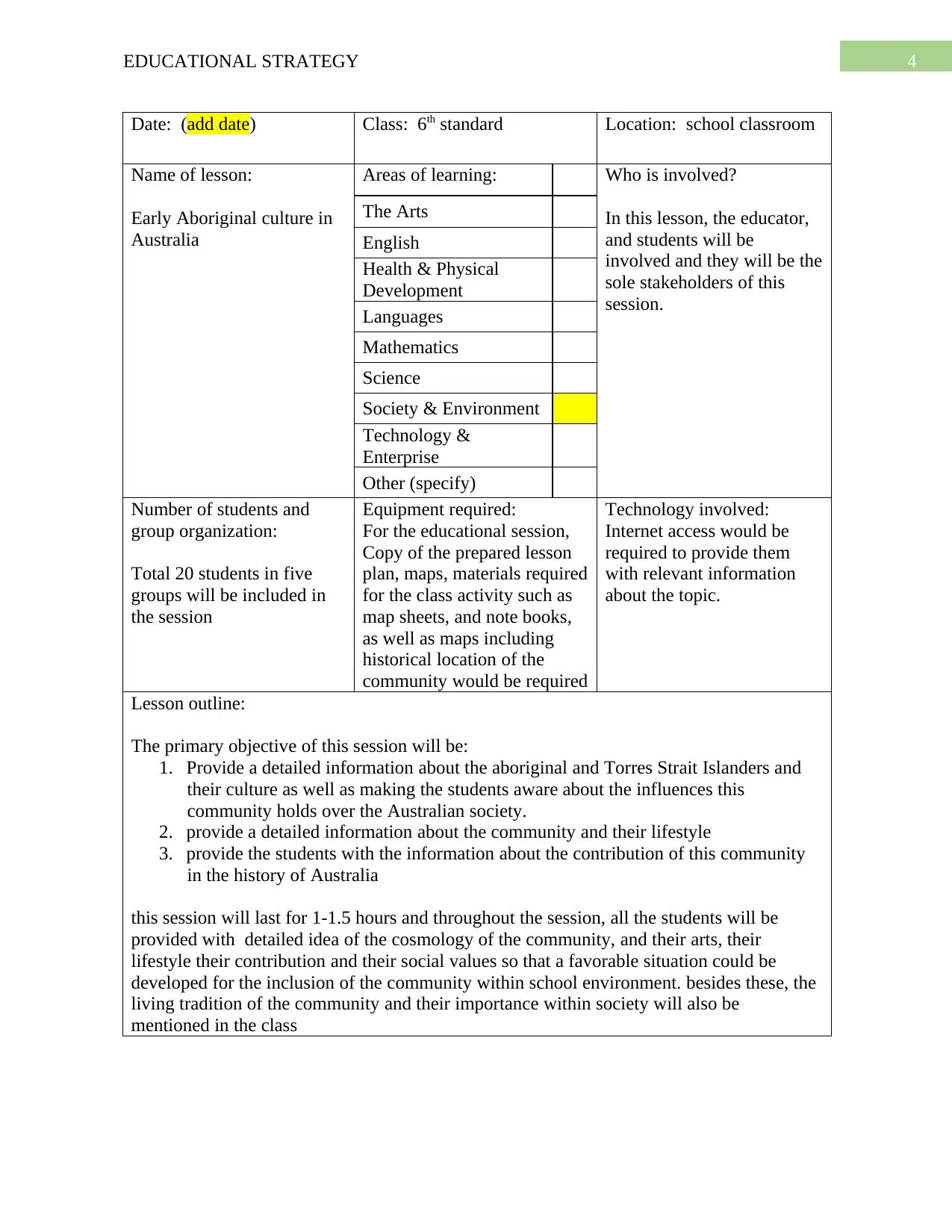
4EDUCATIONAL STRATEGY
Date: (add date) Class: 6th standard Location: school classroom
Name of lesson:
Early Aboriginal culture in
Australia
Areas of learning: Who is involved?
In this lesson, the educator,
and students will be
involved and they will be the
sole stakeholders of this
session.
The Arts
English
Health & Physical
Development
Languages
Mathematics
Science
Society & Environment
Technology &
Enterprise
Other (specify)
Number of students and
group organization:
Total 20 students in five
groups will be included in
the session
Equipment required:
For the educational session,
Copy of the prepared lesson
plan, maps, materials required
for the class activity such as
map sheets, and note books,
as well as maps including
historical location of the
community would be required
Technology involved:
Internet access would be
required to provide them
with relevant information
about the topic.
Lesson outline:
The primary objective of this session will be:
1. Provide a detailed information about the aboriginal and Torres Strait Islanders and
their culture as well as making the students aware about the influences this
community holds over the Australian society.
2. provide a detailed information about the community and their lifestyle
3. provide the students with the information about the contribution of this community
in the history of Australia
this session will last for 1-1.5 hours and throughout the session, all the students will be
provided with detailed idea of the cosmology of the community, and their arts, their
lifestyle their contribution and their social values so that a favorable situation could be
developed for the inclusion of the community within school environment. besides these, the
living tradition of the community and their importance within society will also be
mentioned in the class
Date: (add date) Class: 6th standard Location: school classroom
Name of lesson:
Early Aboriginal culture in
Australia
Areas of learning: Who is involved?
In this lesson, the educator,
and students will be
involved and they will be the
sole stakeholders of this
session.
The Arts
English
Health & Physical
Development
Languages
Mathematics
Science
Society & Environment
Technology &
Enterprise
Other (specify)
Number of students and
group organization:
Total 20 students in five
groups will be included in
the session
Equipment required:
For the educational session,
Copy of the prepared lesson
plan, maps, materials required
for the class activity such as
map sheets, and note books,
as well as maps including
historical location of the
community would be required
Technology involved:
Internet access would be
required to provide them
with relevant information
about the topic.
Lesson outline:
The primary objective of this session will be:
1. Provide a detailed information about the aboriginal and Torres Strait Islanders and
their culture as well as making the students aware about the influences this
community holds over the Australian society.
2. provide a detailed information about the community and their lifestyle
3. provide the students with the information about the contribution of this community
in the history of Australia
this session will last for 1-1.5 hours and throughout the session, all the students will be
provided with detailed idea of the cosmology of the community, and their arts, their
lifestyle their contribution and their social values so that a favorable situation could be
developed for the inclusion of the community within school environment. besides these, the
living tradition of the community and their importance within society will also be
mentioned in the class

5EDUCATIONAL STRATEGY
The lesson provided to the students through this plan should provide the students with a
detailed idea of the Aboriginal and Torres Strait islanders and their cultural and social values so
that a culturally competent environment could be developed within the school (Lloyd et al.
2015). Further, understanding of the community and its contribution to the Australian society
and its integrity was spread to the students through this session so that discrimination, social
exclusion and bullying within the school facility could be avoided within school facility (Dobia
and Roffey 2017).
Several information regarding the aboriginal and Torres Strait islanders will be included
in the lesson plan which requires proper description and management will be transferred to the
students with proper documents. This is because informations such as cultural values and beliefs,
information about the lack within the community or the history of their growth and development
is important to the aboriginal community and could lead to discrimination among students within
the school (Green et al. 2014). Hence, proper management of such information will be ensured.
Involving aboriginal and Torres Strait islanders within the planning of such lesson is an
important step using which, the above-mentioned concern could be resolved (Dobia and Roffey
2017). For this purpose, the details and informations which should be spread among the students
will be verified by the community representatives within the school facility or the parents of the
students belonging to such community so that proper knowledge could be transferred to the
students through this lesson plan (Lloyd et al. 2015).
Answer 3
Parents, families and communities play an important role in child’s growth development
and affects their education, their mental growth and physical development (Tilbury 2015). Parker
The lesson provided to the students through this plan should provide the students with a
detailed idea of the Aboriginal and Torres Strait islanders and their cultural and social values so
that a culturally competent environment could be developed within the school (Lloyd et al.
2015). Further, understanding of the community and its contribution to the Australian society
and its integrity was spread to the students through this session so that discrimination, social
exclusion and bullying within the school facility could be avoided within school facility (Dobia
and Roffey 2017).
Several information regarding the aboriginal and Torres Strait islanders will be included
in the lesson plan which requires proper description and management will be transferred to the
students with proper documents. This is because informations such as cultural values and beliefs,
information about the lack within the community or the history of their growth and development
is important to the aboriginal community and could lead to discrimination among students within
the school (Green et al. 2014). Hence, proper management of such information will be ensured.
Involving aboriginal and Torres Strait islanders within the planning of such lesson is an
important step using which, the above-mentioned concern could be resolved (Dobia and Roffey
2017). For this purpose, the details and informations which should be spread among the students
will be verified by the community representatives within the school facility or the parents of the
students belonging to such community so that proper knowledge could be transferred to the
students through this lesson plan (Lloyd et al. 2015).
Answer 3
Parents, families and communities play an important role in child’s growth development
and affects their education, their mental growth and physical development (Tilbury 2015). Parker
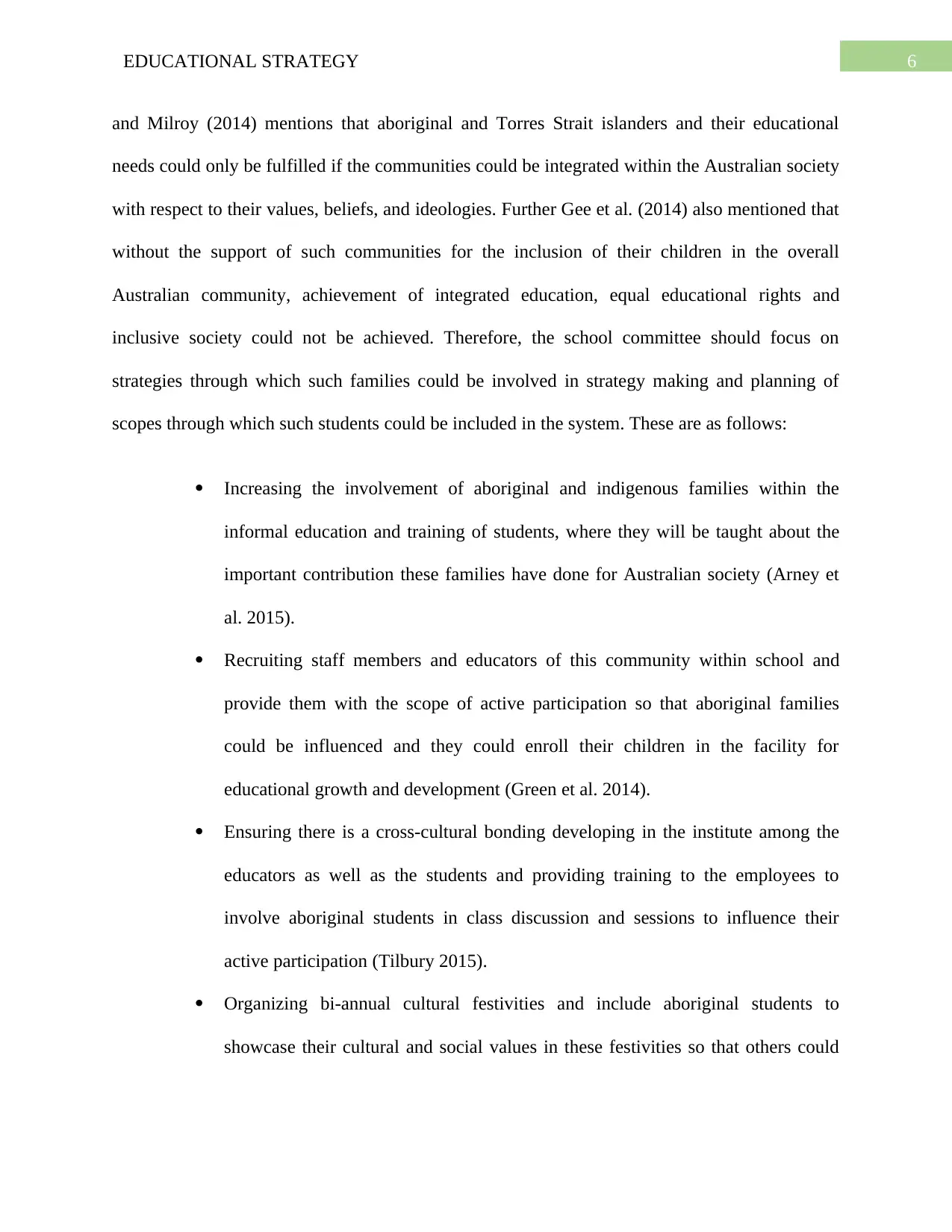
6EDUCATIONAL STRATEGY
and Milroy (2014) mentions that aboriginal and Torres Strait islanders and their educational
needs could only be fulfilled if the communities could be integrated within the Australian society
with respect to their values, beliefs, and ideologies. Further Gee et al. (2014) also mentioned that
without the support of such communities for the inclusion of their children in the overall
Australian community, achievement of integrated education, equal educational rights and
inclusive society could not be achieved. Therefore, the school committee should focus on
strategies through which such families could be involved in strategy making and planning of
scopes through which such students could be included in the system. These are as follows:
Increasing the involvement of aboriginal and indigenous families within the
informal education and training of students, where they will be taught about the
important contribution these families have done for Australian society (Arney et
al. 2015).
Recruiting staff members and educators of this community within school and
provide them with the scope of active participation so that aboriginal families
could be influenced and they could enroll their children in the facility for
educational growth and development (Green et al. 2014).
Ensuring there is a cross-cultural bonding developing in the institute among the
educators as well as the students and providing training to the employees to
involve aboriginal students in class discussion and sessions to influence their
active participation (Tilbury 2015).
Organizing bi-annual cultural festivities and include aboriginal students to
showcase their cultural and social values in these festivities so that others could
and Milroy (2014) mentions that aboriginal and Torres Strait islanders and their educational
needs could only be fulfilled if the communities could be integrated within the Australian society
with respect to their values, beliefs, and ideologies. Further Gee et al. (2014) also mentioned that
without the support of such communities for the inclusion of their children in the overall
Australian community, achievement of integrated education, equal educational rights and
inclusive society could not be achieved. Therefore, the school committee should focus on
strategies through which such families could be involved in strategy making and planning of
scopes through which such students could be included in the system. These are as follows:
Increasing the involvement of aboriginal and indigenous families within the
informal education and training of students, where they will be taught about the
important contribution these families have done for Australian society (Arney et
al. 2015).
Recruiting staff members and educators of this community within school and
provide them with the scope of active participation so that aboriginal families
could be influenced and they could enroll their children in the facility for
educational growth and development (Green et al. 2014).
Ensuring there is a cross-cultural bonding developing in the institute among the
educators as well as the students and providing training to the employees to
involve aboriginal students in class discussion and sessions to influence their
active participation (Tilbury 2015).
Organizing bi-annual cultural festivities and include aboriginal students to
showcase their cultural and social values in these festivities so that others could
Paraphrase This Document
Need a fresh take? Get an instant paraphrase of this document with our AI Paraphraser
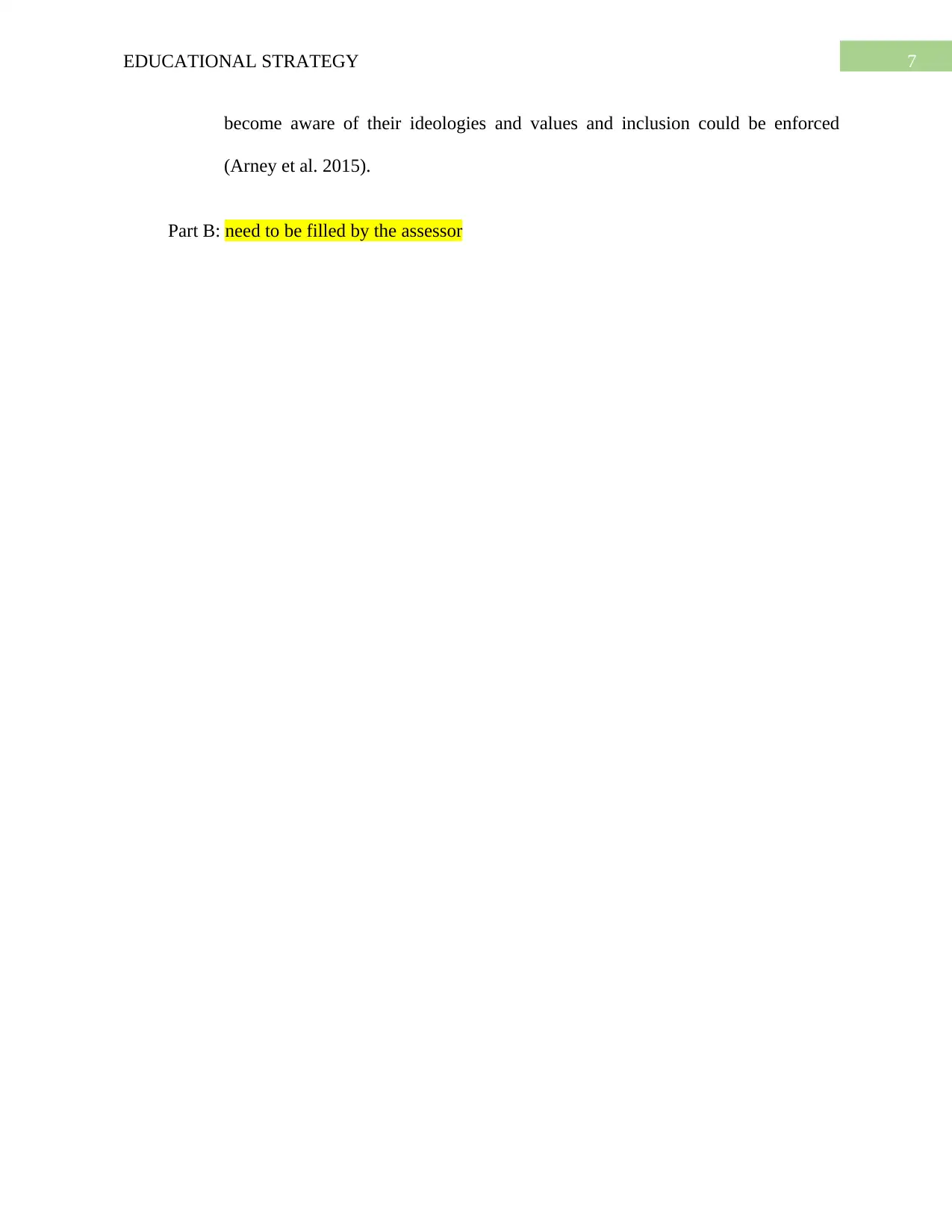
7EDUCATIONAL STRATEGY
become aware of their ideologies and values and inclusion could be enforced
(Arney et al. 2015).
Part B: need to be filled by the assessor
become aware of their ideologies and values and inclusion could be enforced
(Arney et al. 2015).
Part B: need to be filled by the assessor
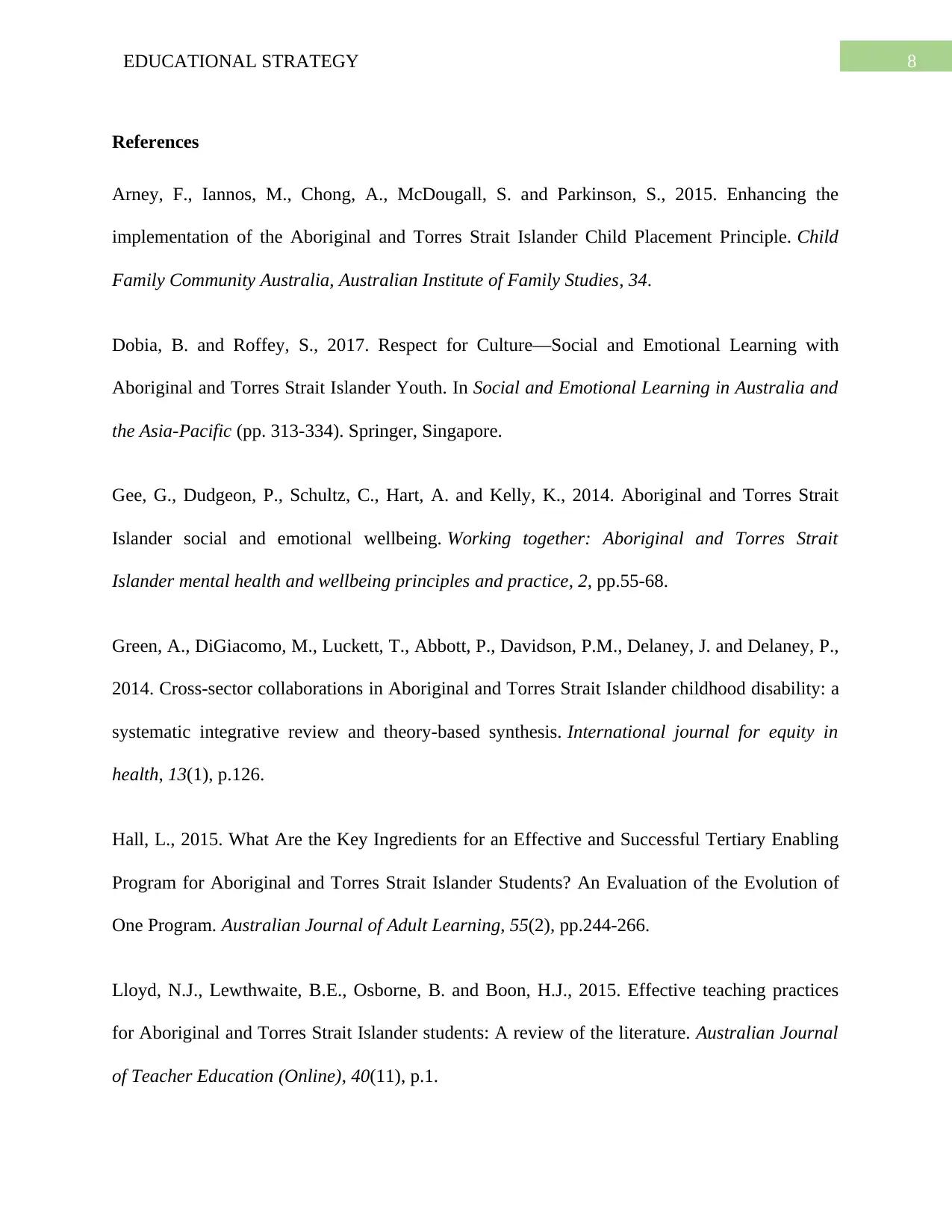
8EDUCATIONAL STRATEGY
References
Arney, F., Iannos, M., Chong, A., McDougall, S. and Parkinson, S., 2015. Enhancing the
implementation of the Aboriginal and Torres Strait Islander Child Placement Principle. Child
Family Community Australia, Australian Institute of Family Studies, 34.
Dobia, B. and Roffey, S., 2017. Respect for Culture—Social and Emotional Learning with
Aboriginal and Torres Strait Islander Youth. In Social and Emotional Learning in Australia and
the Asia-Pacific (pp. 313-334). Springer, Singapore.
Gee, G., Dudgeon, P., Schultz, C., Hart, A. and Kelly, K., 2014. Aboriginal and Torres Strait
Islander social and emotional wellbeing. Working together: Aboriginal and Torres Strait
Islander mental health and wellbeing principles and practice, 2, pp.55-68.
Green, A., DiGiacomo, M., Luckett, T., Abbott, P., Davidson, P.M., Delaney, J. and Delaney, P.,
2014. Cross-sector collaborations in Aboriginal and Torres Strait Islander childhood disability: a
systematic integrative review and theory-based synthesis. International journal for equity in
health, 13(1), p.126.
Hall, L., 2015. What Are the Key Ingredients for an Effective and Successful Tertiary Enabling
Program for Aboriginal and Torres Strait Islander Students? An Evaluation of the Evolution of
One Program. Australian Journal of Adult Learning, 55(2), pp.244-266.
Lloyd, N.J., Lewthwaite, B.E., Osborne, B. and Boon, H.J., 2015. Effective teaching practices
for Aboriginal and Torres Strait Islander students: A review of the literature. Australian Journal
of Teacher Education (Online), 40(11), p.1.
References
Arney, F., Iannos, M., Chong, A., McDougall, S. and Parkinson, S., 2015. Enhancing the
implementation of the Aboriginal and Torres Strait Islander Child Placement Principle. Child
Family Community Australia, Australian Institute of Family Studies, 34.
Dobia, B. and Roffey, S., 2017. Respect for Culture—Social and Emotional Learning with
Aboriginal and Torres Strait Islander Youth. In Social and Emotional Learning in Australia and
the Asia-Pacific (pp. 313-334). Springer, Singapore.
Gee, G., Dudgeon, P., Schultz, C., Hart, A. and Kelly, K., 2014. Aboriginal and Torres Strait
Islander social and emotional wellbeing. Working together: Aboriginal and Torres Strait
Islander mental health and wellbeing principles and practice, 2, pp.55-68.
Green, A., DiGiacomo, M., Luckett, T., Abbott, P., Davidson, P.M., Delaney, J. and Delaney, P.,
2014. Cross-sector collaborations in Aboriginal and Torres Strait Islander childhood disability: a
systematic integrative review and theory-based synthesis. International journal for equity in
health, 13(1), p.126.
Hall, L., 2015. What Are the Key Ingredients for an Effective and Successful Tertiary Enabling
Program for Aboriginal and Torres Strait Islander Students? An Evaluation of the Evolution of
One Program. Australian Journal of Adult Learning, 55(2), pp.244-266.
Lloyd, N.J., Lewthwaite, B.E., Osborne, B. and Boon, H.J., 2015. Effective teaching practices
for Aboriginal and Torres Strait Islander students: A review of the literature. Australian Journal
of Teacher Education (Online), 40(11), p.1.
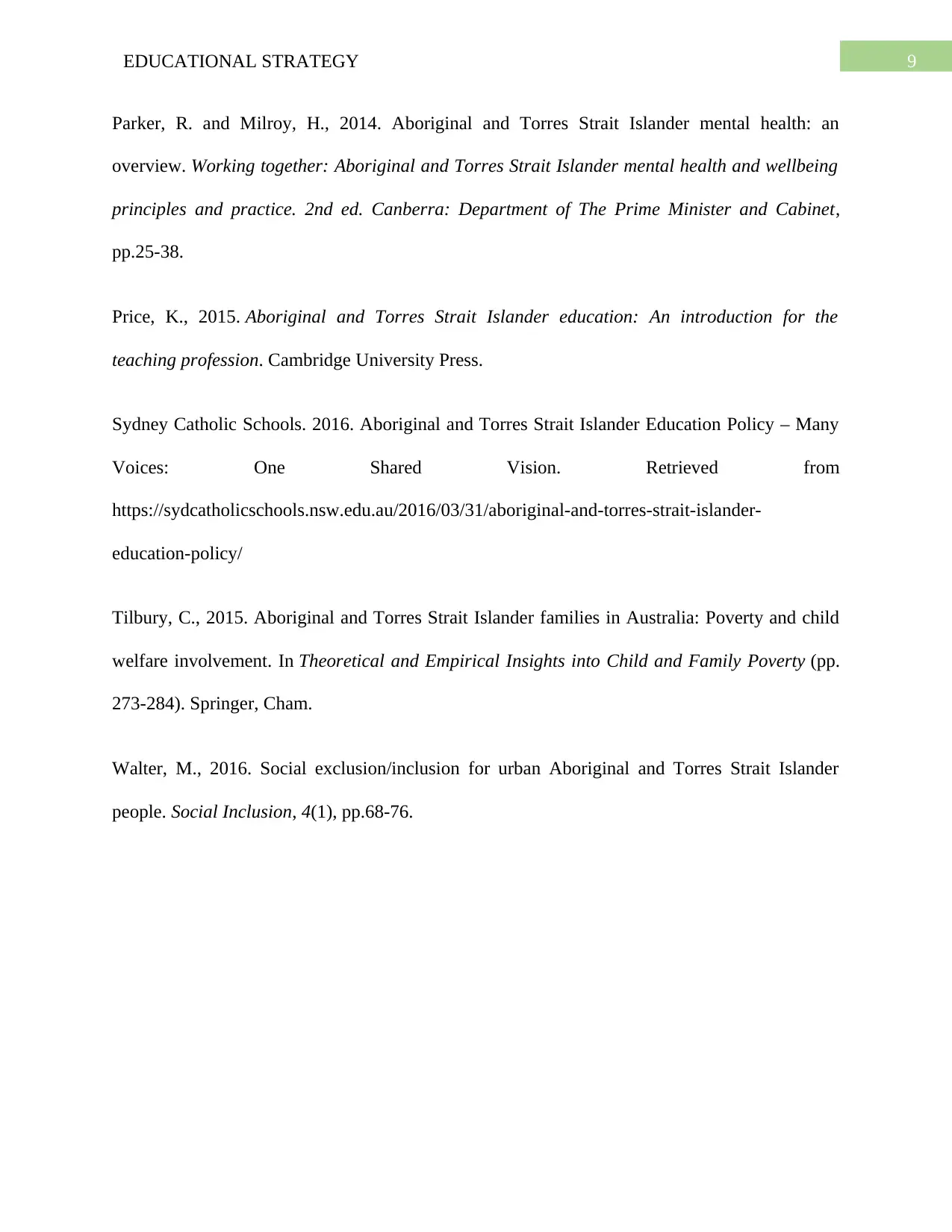
9EDUCATIONAL STRATEGY
Parker, R. and Milroy, H., 2014. Aboriginal and Torres Strait Islander mental health: an
overview. Working together: Aboriginal and Torres Strait Islander mental health and wellbeing
principles and practice. 2nd ed. Canberra: Department of The Prime Minister and Cabinet,
pp.25-38.
Price, K., 2015. Aboriginal and Torres Strait Islander education: An introduction for the
teaching profession. Cambridge University Press.
Sydney Catholic Schools. 2016. Aboriginal and Torres Strait Islander Education Policy – Many
Voices: One Shared Vision. Retrieved from
https://sydcatholicschools.nsw.edu.au/2016/03/31/aboriginal-and-torres-strait-islander-
education-policy/
Tilbury, C., 2015. Aboriginal and Torres Strait Islander families in Australia: Poverty and child
welfare involvement. In Theoretical and Empirical Insights into Child and Family Poverty (pp.
273-284). Springer, Cham.
Walter, M., 2016. Social exclusion/inclusion for urban Aboriginal and Torres Strait Islander
people. Social Inclusion, 4(1), pp.68-76.
Parker, R. and Milroy, H., 2014. Aboriginal and Torres Strait Islander mental health: an
overview. Working together: Aboriginal and Torres Strait Islander mental health and wellbeing
principles and practice. 2nd ed. Canberra: Department of The Prime Minister and Cabinet,
pp.25-38.
Price, K., 2015. Aboriginal and Torres Strait Islander education: An introduction for the
teaching profession. Cambridge University Press.
Sydney Catholic Schools. 2016. Aboriginal and Torres Strait Islander Education Policy – Many
Voices: One Shared Vision. Retrieved from
https://sydcatholicschools.nsw.edu.au/2016/03/31/aboriginal-and-torres-strait-islander-
education-policy/
Tilbury, C., 2015. Aboriginal and Torres Strait Islander families in Australia: Poverty and child
welfare involvement. In Theoretical and Empirical Insights into Child and Family Poverty (pp.
273-284). Springer, Cham.
Walter, M., 2016. Social exclusion/inclusion for urban Aboriginal and Torres Strait Islander
people. Social Inclusion, 4(1), pp.68-76.
1 out of 10
Related Documents
Your All-in-One AI-Powered Toolkit for Academic Success.
+13062052269
info@desklib.com
Available 24*7 on WhatsApp / Email
![[object Object]](/_next/static/media/star-bottom.7253800d.svg)
Unlock your academic potential
© 2024 | Zucol Services PVT LTD | All rights reserved.





